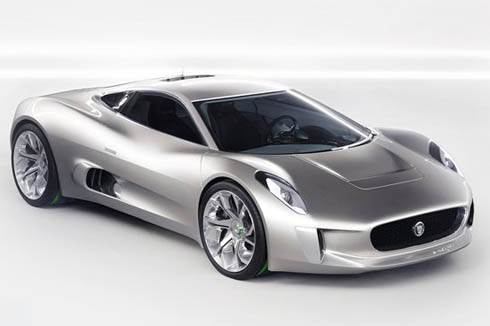Jaguar has made waves on the eve of the
But internally, as Autocar can reveal, Jaguar considers the car almost wholly realistic for production and it has ambitions to bring it to the road, relaunching Jaguar as a powerful, forward-looking force in the supercar world.
“With the current XK, XF and XJ, we’ve refreshed and enhanced the public’s perception of the Jaguar brand,” explained deputy design director Julian Thomson. “The time’s right for us to push on again. To make people aware that we can make an even more exotic and special kind of car — a true supercar that’s sustainable and future-proof, and that also combines performance, luxury and beauty in a way that only a Jaguar can.”
What makes the C-X75 particularly remarkable is its experimental powertrain. Powering this 4.6m-long, 205mph, two-seat berlinetta are four 195bhp electric motors, one at each wheel. They give a combined 780bhp and 1180lb ft of torque, and provide for zero-emissions running, dynamics-enhancing torque vectoring, and pace that even an XJ220 couldn’t match: 0-62mph in 3.4sec, 0-100mph in 5.5sec and 0-186mph in a Veyron-beating 15.7sec.
“The electric powertrain gave us total freedom to give the C-X75 absolutely perfect stance and proportion,” said Thomson. “In conventional supercars, you’re hampered by accommodating a large piston engine, but using four relatively small electric motors instead meant we could keep the car low to the ground and put the driver precisely in the middle of the wheelbase, right where you’d ideally like to be.”
Jaguar design chief Ian Callum is already on record with his view that this car is the most beautiful Jaguar that the company has ever produced — prettier, even, than the 1966 XJ13 prototype racer.
He said: “The C-X75 is as close to a pure art form as a concept car can get.” Its grille and headlights, and pure fuselage-like body surfaces, are also a clue towards the looks of Jaguar’s next XK, and its often-rumoured smaller sports car.
The C-X75 is no strict EV but a range-extended plug-in hybrid of an unprecedented sort. It has an electric-only range of 68 miles, but backing this up is a pair of miniature gas turbines mounted behind the cabin that could be run on diesel, biofuel, compressed natural gas or LPG.
The turbines produce 188bhp (140kw) of electrical power spinning at 80,000rpm. This can be used either to supplement the output of the car’s lithium-ion batteries or to recharge them on the run and extend the car’s cruising range to a theoretical 560-mile maximum. The turbines, made by
“The turbines are a designer’s dream,” he told us. “They’re compact, efficient and much lower maintenance than a piston engine. They also give us the opportunity to give the C-X75 active aerodynamics.” In Jaguar’s vision for the car, the turbines’ hot exhaust gas could, at the flick of a switch, be channeled under the C-X75 and past its large underbody venturi, increasing downforce on demand.
“The turbines are also magnificent to look at,” Thomson said. “They’ve provided an aeronautical inspiration for the styling of the C-X75, which is a perfect match for Jaguar.” The experimental supercar has 21in and 22in alloy wheels and air vents designed to mimic its turbines’ look. It also has a jet-fighter-like roof-mounted control panel, an aircraft throttle-style gear selector, and interior door handles situated between the occupants’ legs, designed like ejection handles.
Underpinning the C-X75 is a bonded aluminium chassis similar to the one used in Jaguar’s current production range and it contributes to a low overall kerb weight of 1350kg.Cabin highlights include gimbal-style LCD instruments, fixed seats, an adjustable pedal box, steering column and instrument panel, and Bowers & Wilkins hi-fi nano speakers hidden behind perforated wave-formed door panels.
Matt Saunders for Autocar




Comments
Member Login
Personal Details
No comments yet. Be the first to comment.